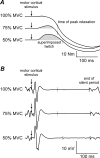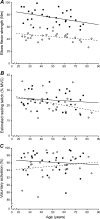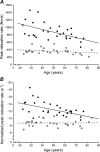Effects of aging and sex on voluntary activation and peak relaxation rate of human elbow flexors studied with motor cortical stimulation
- PMID: 22653296
- PMCID: PMC3705101
- DOI: 10.1007/s11357-012-9435-5
Effects of aging and sex on voluntary activation and peak relaxation rate of human elbow flexors studied with motor cortical stimulation
Abstract
Data are equivocal on whether voluntary activation is preserved or decreased in old compared to young adults. Further, data are scant on the effect of age on the rate of muscle relaxation when the muscle is contracting voluntarily. Assessment of both measures with transcranial magnetic stimulation (TMS) yields information which cannot be obtained with traditional peripheral nerve stimulation. Hence, voluntary activation and peak relaxation rate of the elbow flexors were assessed with TMS during repeated maximal efforts in 30 men and 28 women between the ages of 22-84 years. Voluntary activation was similar for the two sexes (P = 0.154) and was not affected by age in men (96.2 ± 2.7 %; P = 0.887) or women (95.1 ± 3.0 %; P = 0.546). Men had a significantly faster peak rate of relaxation than women in absolute units (-880.0 ± 223.2 vs. -360.2 ± 78.5 Nm/ s, respectively; P < 0.001) and when normalized to subject strength (-12.5 ± 2.1 vs. -8.7 ± 1.0 s(-1), respectively; P < 0.001). Absolute and normalized relaxation rates slowed with age in men (P = 0.002 and P = 0.006, respectively), but not women (P = 0.142 and P = 0.950, respectively). Across the age range studied, all subjects, regardless of age or sex, were able to achieve high voluntary activation scores for the elbow flexors (~95 %). In contrast, peak relaxation rate was markedly faster in men than women and slowed with age in men but not women. Normalization of relaxation rates to strength did not affect the influence of age or sex.
Figures





Similar articles
-
Sex differences with aging in the fatigability of dynamic contractions.Exp Gerontol. 2015 Oct;70:1-10. doi: 10.1016/j.exger.2015.07.001. Epub 2015 Jul 6. Exp Gerontol. 2015. PMID: 26159162 Free PMC article.
-
Use of motor cortex stimulation to measure simultaneously the changes in dynamic muscle properties and voluntary activation in human muscles.J Appl Physiol (1985). 2007 May;102(5):1756-66. doi: 10.1152/japplphysiol.00962.2006. Epub 2007 Jan 11. J Appl Physiol (1985). 2007. PMID: 17218428
-
Measurement of voluntary activation of fresh and fatigued human muscles using transcranial magnetic stimulation.J Physiol. 2003 Sep 1;551(Pt 2):661-71. doi: 10.1113/jphysiol.2003.044099. Epub 2003 Aug 8. J Physiol. 2003. PMID: 12909682 Free PMC article. Clinical Trial.
-
Measurement of voluntary activation based on transcranial magnetic stimulation over the motor cortex.J Appl Physiol (1985). 2016 Sep 1;121(3):678-86. doi: 10.1152/japplphysiol.00293.2016. Epub 2016 Jul 14. J Appl Physiol (1985). 2016. PMID: 27418687 Review.
-
Transcranial magnetic stimulation and human muscle fatigue.Muscle Nerve. 2001 Jan;24(1):18-29. doi: 10.1002/1097-4598(200101)24:1<18::aid-mus2>3.0.co;2-d. Muscle Nerve. 2001. PMID: 11150962 Review.
Cited by
-
Sex Differences in Adaptations in Muscle Strength and Size Following Resistance Training in Older Adults: A Systematic Review and Meta-analysis.Sports Med. 2021 Mar;51(3):503-517. doi: 10.1007/s40279-020-01388-4. Sports Med. 2021. PMID: 33332016
-
Sex differences in the rate of torque development and torque-velocity relationship are due to maximal strength only.Eur J Appl Physiol. 2025 Jun 10. doi: 10.1007/s00421-025-05836-9. Online ahead of print. Eur J Appl Physiol. 2025. PMID: 40493173
-
KBTBD13 is an actin-binding protein that modulates muscle kinetics.J Clin Invest. 2020 Feb 3;130(2):754-767. doi: 10.1172/JCI124000. J Clin Invest. 2020. PMID: 31671076 Free PMC article.
-
Assessment of calf muscle fatigue during submaximal exercise using transcranial magnetic stimulation versus transcutaneous motor nerve stimulation.Eur J Appl Physiol. 2014 Jan;114(1):113-21. doi: 10.1007/s00421-013-2757-x. Epub 2013 Oct 23. Eur J Appl Physiol. 2014. PMID: 24150785
-
Use of transcranial magnetic stimulation to assess relaxation rates in unfatigued and fatigued knee-extensor muscles.Exp Brain Res. 2021 Jan;239(1):205-216. doi: 10.1007/s00221-020-05921-9. Epub 2020 Nov 2. Exp Brain Res. 2021. PMID: 33140192 Free PMC article.
References
Publication types
MeSH terms
LinkOut - more resources
Full Text Sources
Medical
